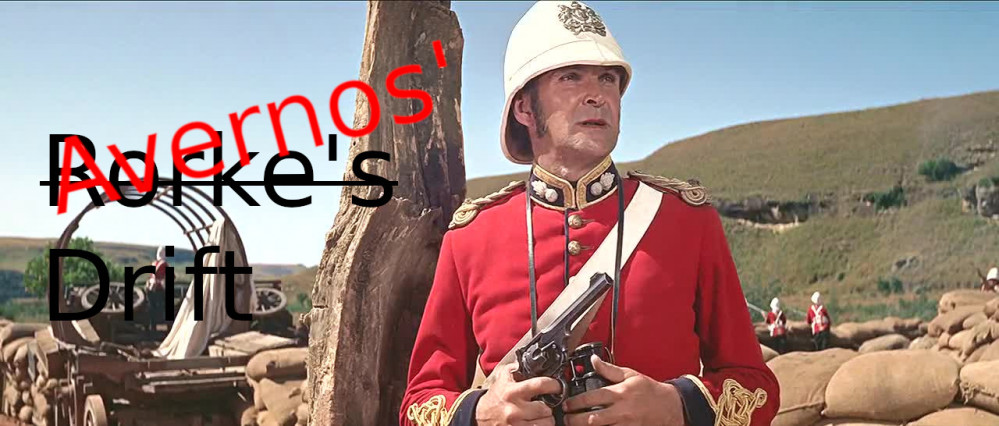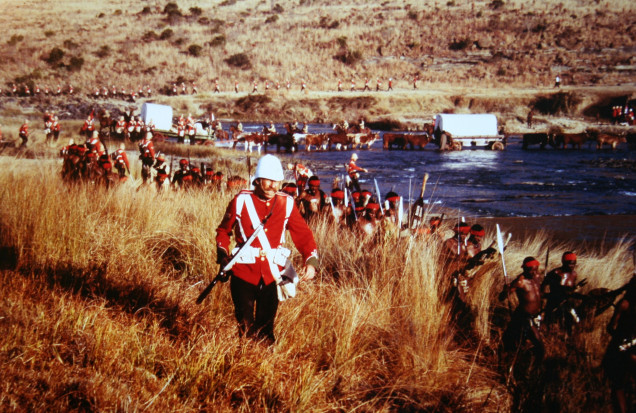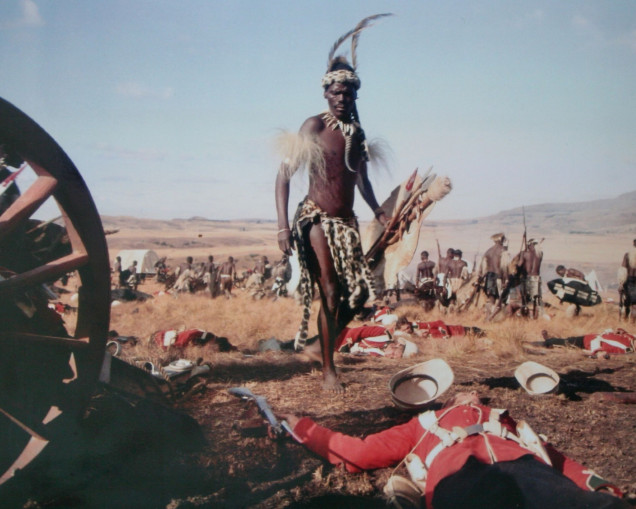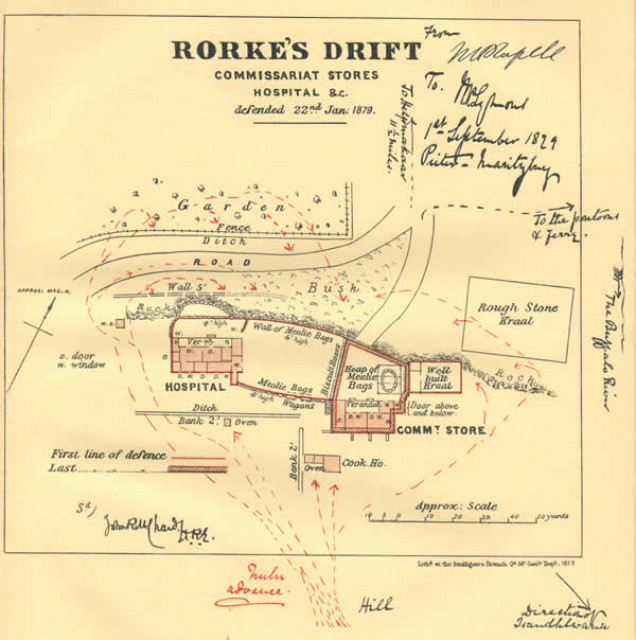
Avernos' Rorke's Drift
The Defence of Rorke's Drift
So it’s possible some people haven’t seen the film Zulu (shame on you) nevermind have read about the defense of the Mission Station of Rorke’s Drift 22-23 January 1879. To that end here is a, very, brief breakdown of the action and the reasons it happened.
In December 1878 an ultimatum was delivered to the Zulu king from the British neighbouring land of Natal. It required that the Zulus to disband their military and they had two weeks to comply. The reasons for this was due to the British idea to unite the south of africa and an independant Zulu kingdom on the borderlands prevented this. The Zulu nation itself was a military society, built like the Spartans, to disband their armies would be to abandon their way of life and so to continue their way of life they had to reject the ultimatum!
Chelmsford’s army was split into three columns and advanced into Zululand. It was slow going and a few minor skirmishes and the British superiority in training and technology lead to a dangerous mix of arrogant self-belief and contempt for their “savage opponents”. Having made slow going of only 11 miles in as many days this lead to Chelmsford taking the cavalry, nearly two thirds of the army, and advancing alone after what he believed to be the Zulu army of 20,000 men.
It was the morning of 22nd January.
The remaining third of the army, the supply wagons and infantry numbering approximately 1750 men, at the camp at Isandlwana was attacked at 8am by the main body of Cetshwayo’s force. Despite several opportunities to return and support the camp Chelmsford stuck to his plan in the belief he was pursuing the Zulu army. As such by 15:00 despite severe casualties the Zulus had defeated the British, less than 400 men survived the attack. The biggest defeat for a modern military against natives to date.
This then, is the set up for the attack on Rorke’s Drift. 4500 Zulus, who were part of the reserve force at Isandlwana crossed the river and attacked the British depot at the Drift. In many respect this was the worst thing they could have done. Attacking against orders, outside of the borders of Zululand, it gave the excuse for the repercussions and pursuit for the rest of the war. But that aside, what of the action itself.
The station at the Drift was an muntions dump and hospital, when news arrived via members of the ill fated expedition of the destruction of the force at Isandlwana that morning the decision was made to fortify and hold the camp, rather than attempt to flee with the patients in the hospital. Dalton is believed to be largely responsible for arguing this case to Bromhead and Chard.
Members of Durnford’s horse who arrived performed a small delaying action emptying the last of their ammunition into the oncoming Zulus before retreating towards Helpmekaar, seeing the retreating horsemen the untried 200 or so Natal Native Contingent fled, and This left 154 more inscribed on the rolls as defending Rorke’s Drift, included in this number are members of the Army Commissariat and Transport Department and Army Medical Department and Army Hospital Corps, along with the walking wounded in the hospital who aided the defense. This left roughly 130 fit regulars against over 30 times their numbers.
The buildings James Rorke had built for his trading post stood on top a small stone ledge, roughly 4-5 feet in height (120-150cm). The British defenders made a wall of mealie bags along this natural defensive line and connected it to the buildings, a stone cattle kraal (pen) and to the rear two wagons were used to reinforce the wall between the buildings.
Further to this Chard, the commanding officer, had a wall of tin and biscuit boxes built at the store house come church. This gave a secondary smaller defensive area to retreat to should it be warranted and inside this a final redoubt was built.
When the Zulus arrived and began their attacks it was roughly 16:30 and they came over the rear, encircled the defensive island the defenders had created attacking piecemeal from the south and west of the station. It wasn’t until the arrival of Prince Dabulamanzi kaMpande, the half brother of King Cetshwayo, that the attacks became more concerted. With black powder armed Zulus on the slopes of the Oskarberg ridge sniping at the defenders constantly harassing them from afar.
At some point Zulus managed to set the hospital alight, no definite time is given for this but we do know that the hospital had been evacuated between 18:00 and 19:00, and the men had fallen back to the smaller defensive position around the redoubt. So it must have occurred just prior to, or during the Zulu assault then.
The light cast by the burning hospital did help though for several assaults were launched overnight and repulsed the the glow of the blazing building.
By the dawn of the early morning nearly every defender had received some form of injury, first light on the morning 23nd January, 1879 brought the defenders a sight of utter devastation; hundreds of Zulu dead ringed the post, the air reeked of burnt flesh from the hospital – but the Zulus were gone. Although the defenders did not know it then, it was the return of the cavalry elements of Lord Chelmsford’s force that Zulu scouts having spotted in the distance lead to them retreating back across the Buffalo River.
Over 12 hours the defenders had repulsed countless probing attacks from a force many times their number of the one hundred and fifty, or so, of the defenders, fifteen had died outright, two others would died from their wounds, and sixteen others had been wounded. Roughly five hundred Zulus were killed.
Eleven of the defenders were awarded the Victoria Cross, and five others were nominated for the Distinguished Service Medal. A count ordered by Chard before the relief column reached them found that out of the 20,000 rounds of ammunition stored at the Drift before the defense, 900 rounds were left.

































![How To Paint Moonstone’s Nanny | Goblin King Games [7 Days Early Access]](https://images.beastsofwar.com/2024/12/3CU-Gobin-King-Games-Moonstone-Shades-Nanny-coverimage-225-127.jpg)











































Excellent! A great summation of the events. Looking forward to more.
thanks, it’s hard to sum up something that people have literally written books about, but it gives a decent flavour of what happened. Next up will be the ruleset and amendments.
Very cool to see this project I’ll be following it closely.
Chard was actually at Isandlwana earlier that day wasn’t he? I remember something about him leading some Engineers there but they only wanted his men and he was sent back to Rorke’s Drift before the battle.
I didn’t know about the ammunition, that could have gone very badly.
He arrived at Rorke’s Drift on the 19th and was left in command, at one point he lead a scouting detachment into Zululand on the 22nd but a runner from Bromhead brought him back before any engagement. Ardendorf is the only person to have fought at both battles.
The first time I read the ammo numbers I was shocked. Even if you assume most men had full pouches, it really demonstrates how the British training essentially turned ranks of men into machine guns.
Nice work Mr G